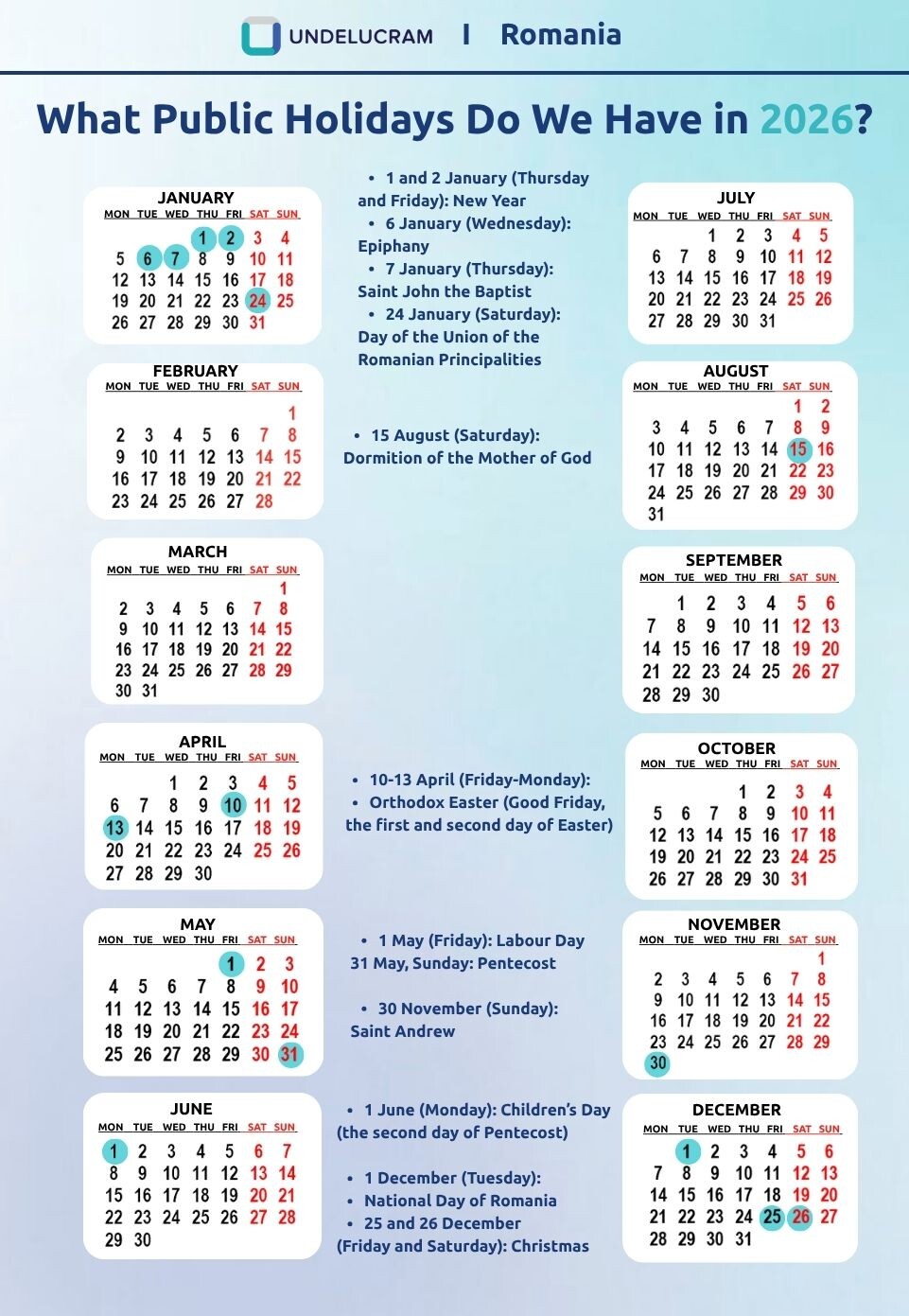Share
What public holidays do we have in 2026?

It’s already November. Tomorrow is almost here and we realise that New Year’s is about to be celebrated. In addition to the joy of spending time with loved ones, the onset of the new year brings good news for those in the workforce. The year 2026 will offer numerous excellent occasions for rest and mini-vacations: beyond the weekends, employees in Romania will have several legal public holidays which, with a little planning, can be leveraged for relaxation or get-aways. In this article we will see which legal public holidays there are in 2026 for Romania, how they are distributed (how many fall during the week and how many on weekends), and we’ll offer some practical advice on how you can optimise them for successful mini-vacations.
Public Holidays in 2026
Here is the complete list of legal public holidays in Romania for 2026, according to the official calendar. These include both fixed-date national and religious holidays, and mobile ones such as Orthodox Easter, calculated according to the Eastern tradition.

- 1 and 2 January (Thursday and Friday): New Year – a strong start to the year, with two consecutive days.
- 6 January (Wednesday): Epiphany (Boboteaza).
- 7 January (Thursday): Saint John the Baptist.
- 24 January (Saturday): Day of the Union of the Romanian Principalities (Ziua Unirii Principatelor Române).
- 10-13 April (Friday-Monday): Orthodox Easter (Good Friday, the first and second day of Easter) – four days of celebration.
- 1 May (Friday): Labour Day (Ziua Muncii).
- 1 June (Monday): Children’s Day (and the second day of Pentecost / Rusalii, which falls on 31 May, Sunday).
- 15 August (Saturday): Dormition of the Mother of God (Adormirea Maicii Domnului).
- 30 November (Monday): Saint Andrew (Sfântul Andrei).
- 1 December (Tuesday): National Day of Romania (Ziua Naţională a României).
- 25 and 26 December (Friday and Saturday): Christmas (Crăciunul).
Keep in mind that these days are non-working for most employees, except in essential sectors (such as healthcare or public food services), where compensation is provided.
Attention! If you work on one of these days, you are entitled to double pay or to compensatory days off.
Legal holidays, weekend overlaps and mini-vacations
One thing is clear! 2026 is a generous year: we have 17 legal public holidays in total. Of those, unfortunately, 5 fall on weekends (24 January – Saturday; 31 May – Sunday; 15 August – Saturday; 30 November – Monday; 26 December – Saturday), so they do not add extra time off for those with a standard Monday-to-Friday schedule. However, the other 12 days fall during the week, offering a consistent period for rest.
“Bridge days” and mini-vacations: The New Year period comes with several fortunate alignments, where legal holidays stick to weekends, automatically creating mini-vacations for those in the workforce:
- New Year: 1-2 January (Thursday-Friday) + weekend = 4 consecutive days.
- Easter: 10-13 April (Friday-Monday) = 4 days in a row, perfect for family traditions.
- Pentecost/Rusalii + Children’s Day: 31 May (Sunday) + 1 June (Monday) = extended weekend of 3 days.
- National Day: 1 December (Tuesday) = 4 days with the weekend.
- Christmas: 25 December (Friday) + weekend = 3 days, plus 26 December (Saturday) which extends the magic.
Other notable celebrations? In addition to official holidays, keep in mind events like Dragobete (24 February) or Mărțișor (1 March). These are not officially non-working days, but can serve as occasions for short outings. In total, these alignments can generate over 20 days of actual time off if you combine them with a minimal amount of leave. Compared to 2025, 2026 is friendlier, with fewer holidays “wasted” on weekends.
How to optimise your public holidays for mini-vacations
1. Plan ahead
Identify holidays that fall on Thursday, Friday or Monday and book your transport and accommodation ahead of time. For example: 1 January (Thursday) + 2 January (Friday) → weekend + two legal holidays = 4 consecutive days.
2. Create “bridge days”
If a holiday falls on Tuesday or Wednesday, you can take Monday or Friday off to create a longer vacation with only one extra leave day. For example: 6 January (Tuesday) Epiphany → you can take Monday, 5 January, off → 4 days in a row.
3. Combine legal holidays with annual leave
If you have paid leave days, try to add them before or after the legal holidays to extend your rest period without using many leave days.
4. Be mindful of peak periods
During popular periods (Easter, 1 May, 15 August) demand for accommodation/transport rises – book early to get better prices.
5. Plan with variety
- Mini city-break: For legal holidays that fall on Thursday/Friday or Monday, you can go to a Romanian city or make a short flight abroad.
- Extended stay: If you can take 2-3 additional leave days, you can turn a holiday into a week-long vacation.
6. Check your employer’s rules
If you work in 24/7 operations or shifts, make sure you know how legal holidays are compensated (double pay, compensatory day off etc.).
7. Also consider school holidays
If you have children, plan mini-vacations around school breaks, which in 2026 coincide with holidays like Easter, 1 June and Christmas. That way you can spend more time together without using too many leave days. The spring break or the winter break can be easily extended with legal holiday days — perfect for a mountain escape or a family city-break.
Conclusion
2026 promises a better balance between work and relaxation. With 17 legal public holidays, many of them in the middle of the week, you have every chance to turn weekends into mini-vacations. Whether you plan a spontaneous city break, a mountain getaway or simply a few relaxing days at home with family, the key is early planning. Get your calendar ready from January and make 2026 the year in which you work smart and genuinely rest.
Article written by:
Comments
0 comments

Access your account and add your comment
Labour market
Subscribe to the Newsletter
Read articles of interest from Undelucram.ro contributors




